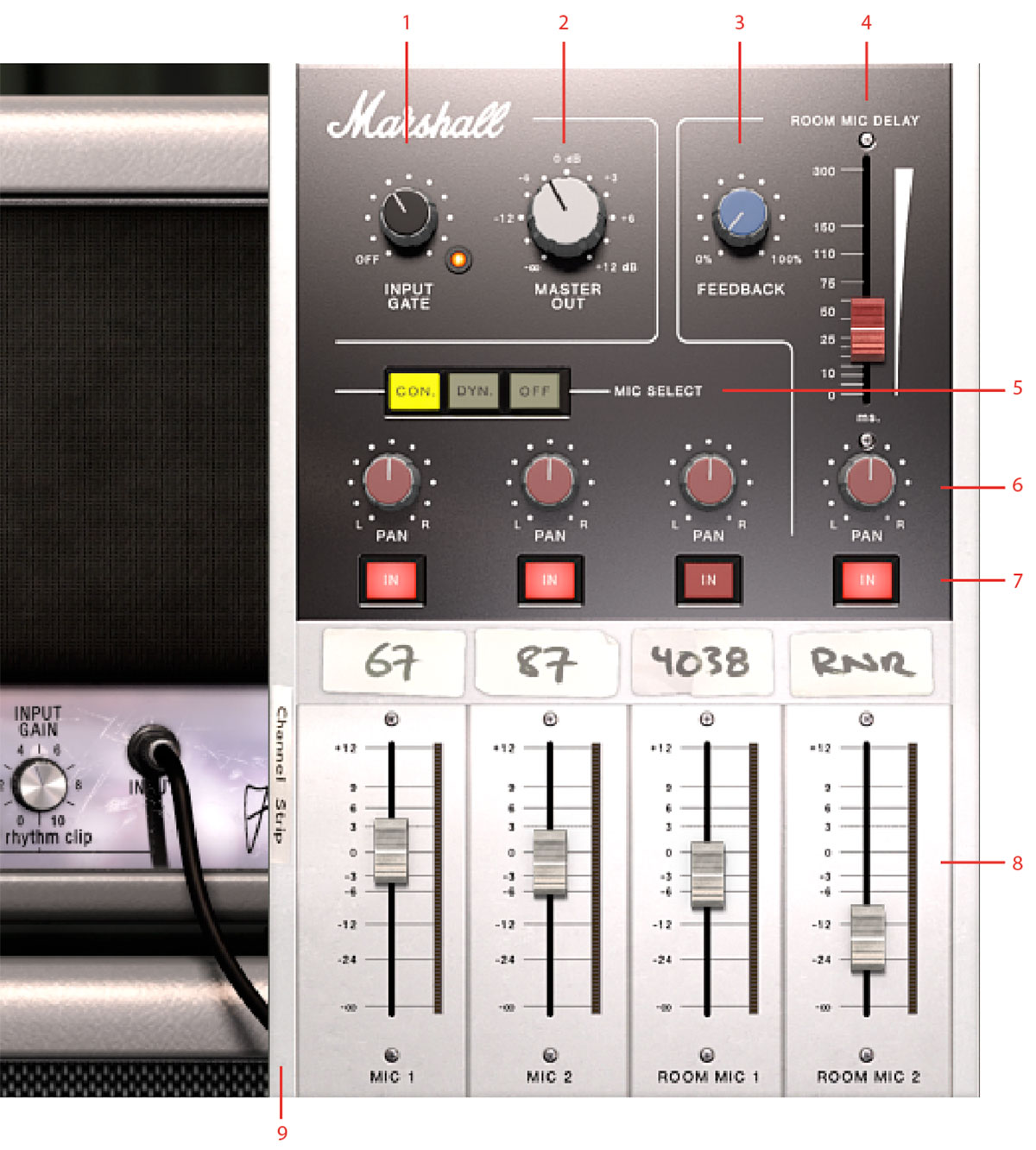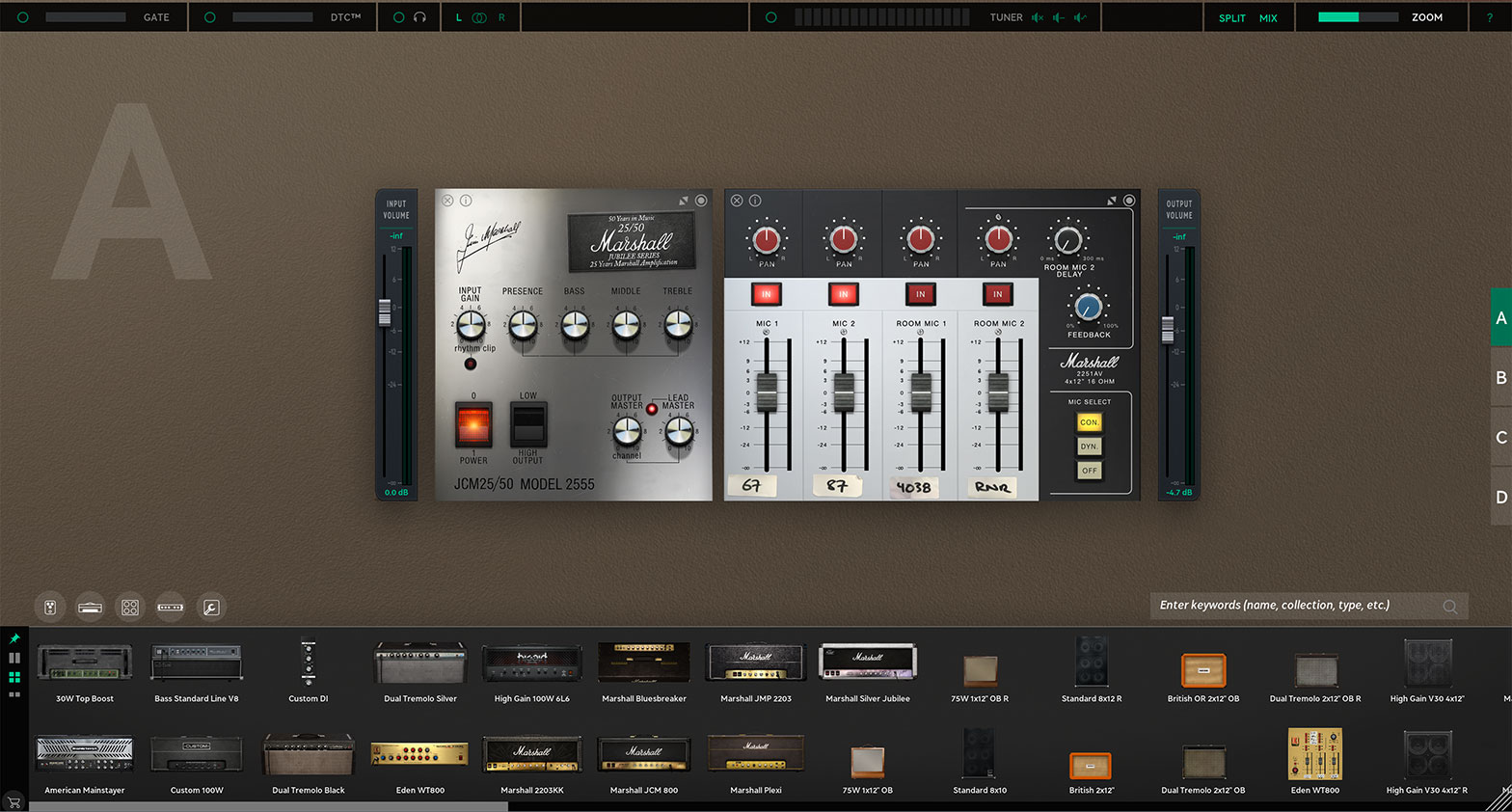User Manual
Marshall Silver Jubilee 2555
Intro
Amplifier Parameters
Channel Strip Parameters
Cabinet and Microphones
Marshall Silver Jubilee 2555 in Amp Room
Extended Features
Related manuals
The very limited Silver Jubilee series came out in 1987 to celebrate Jim Marshall’s 25 years as a guitar amp manufacturer and 50 years of working in the music business. The unique sound and striking appearance of the Silver Jubilee 2555 made it a big hit among guitarists such as Slash (Guns n’ Roses), John Frusciante (Red Hot Chili Peppers) and Alex Lifeson (Rush), and since it was only produced for a limited time, it quickly became a rare collector’s piece.
This plug-in model is based on Marshall’s own golden unit Silver Jubilee 2555, which Marshall have kept to themselves at their headquarters ever since its release. Softube worked closely with Marshall’s product experts and legendary engineer Tony Platt (AC/DC, Iron Maiden, Motorhead and many more) to ensure that the Silver Jubilee was captured in the best possible manner.
Born To Rock
The Silver Jubilee was based on the Marshall JCM800 amplifier, but had an innovative and unusual preamp section which offered higher gain and a somewhat darker and smoother sound compared to the JCM800. The preamp circuit had three gain modes: Clean, Rhythm Clip and Lead. The EQ section also set the Silver Jubilee apart from other Marshall amps with its much wider range of tonal variety, and it was the first Marshall amplifier where the power amp tubes could be switched from their normal pentode operation mode into triode mode. With the power amp tubes working as triodes, the power amp’s output was cut in half, and the power amp distortion was silkier and less aggressive. All of these features have been accurately modeled by Softube in the Marshall Silver Jubilee 2555 plug-in.
Cabinet
Just as with Marshall Plexi Super Lead 1959 and Marshall Bluesbreaker 1962 plug-ins, Softube worked with legendary engineer Tony Platt and Marshall’s own product expert Chris George with the creation of the Marshall Silver Jubilee 2555 plug-in. The cabinet choice was the obvious: the 2551AV, which was also part of the Silver Jubilee series. It was clad in grey tolex, just like the amplifier head, and it was equipped with four 12 inch Marshall Vintage 30 speakers, made by Celestion. Actually, it was the first Marshall cabinet ever to use these speakers.
Eight Microphones
Tony chose to make two microphone sets—Condensor and Dynamic—with two close mics and two room mics in each. The user can open the plug-in’s side panel where an easy to use channel strip appears. Here, the microphone channels can be individually panned, bypassed or have their respective levels set. The second room mic received some special attention, as Softube implemented the studio trick of adding a Delay time to the mic. This was upon Tony’s request, it was a trick that was widely used in the late 80’s studio work to add size to the sound of guitar solos and melody lines. Furthermore, a Noise Gate was added to clean up any guitar noise and get tighter takes when recording.
The front panel controls correspond exactly to those of the real amplifier, with the exception of the channel LED switches, which on the original consists of push/pull potentiometers.
On/Off: Bypass the amplifier.
Output Low/High: Switches the power amp output from pentode (High) to triode (Low) operation. The Low setting reduces the amplifier’s output power and gives a slightly smoother and darker sound.
Presence: Increases the amount of presence—a treble boost accomplished by reducing the amount of high frequencies being subjected to negative feedback in the power amp section.
Bass, Middle and Treble: Tone controls that determine the frequency content from the amplifier.
Output Master: Controls the overall power amp volume.
Channel Lead/Normal: Click to activate/deactivate the Lead channel.
Lead Master: Controls the level of the Lead channel.
Rhythm Clip: Click to activate/deactivate the Rhythm Clip circuit.
Input Gain: Controls the level fed from the guitar input to the preamp section.
Note that clicking any parameter name on the front panel resets the corresponding knob to its 12 o’clock position.
1. On/Off
2. Output Low/High
3. Presence
4. Bass
5. Middle
6. Treble
7. Output Master
8. Channel Lead/Normal
9. Rhythm Clip Clean/Clip
10. Input Gain

Click here to view the full-sized image in a new tab
The channel strip can be opened by clicking the right hand aluminum side with the white Channel Strip sticker. Clicking this again closes the channel strip.
Input Gate: Shuts off the input when the signal level is below the set threshold level, reducing unwanted noise and giving a cleaner and tighter recording. The LED next to the knob indicates when the gate is closed not letting any sound through. Adjust the Input Gate knob to suit your playing style and your guitar’s output. If the gate accidentally cuts of notes you intended to be heard, lower the Input Gate knob. If it lets through everything you wish, in addition to unwanted noise from your guitar, raise the Input Gate knob. The Input Gate is entirely bypassed when set to Off.
Master Out: Sets the overall output level of the plug-in without affecting the sound.
Mic Select: Select which set of microphones to use, see description in the next section. Con refers to condeser mics in the near field position, and Dyn refers to the dynamic mics in near field.
In: Activates/deactivates each microphone channel.
Pan: Places the microphone channel in the desired position in the stereo panorama.
Channel Faders: Adjusts the volume of the respective microphone channel.
Room Mic Delay: A delay line has been added to Room Mic 2, so that the sound from this microphone can be delayed more than it was in real life. The Room Mic Delay fader sets the time of this delay.
Feedback: A feedback loop has been added to the delay line, which sends the signal from this microphone back through the Silver Jubilee cabinet where it’s picked up again by the microphone, etc. The Feedback knob sets the volume in this feedback loop.
1. Input Gate
2. Master Out
3. Feedback
4. Room Mic Delay
5. Mic Select
6. Pan
7. In
8. Channel Faders
9. Click to show or hide the mixer

Click here to view the full-sized image in a new tab
The 16 ohms 2551AV cabinet was recorded with a legendary range of microphones, all carefully selected to give a wide variety of tones, and carefully positioned to sound fantastic when used in combination with each other.
Condenser Microphones
Selects the microphone set with condenser microphones in the near field. As indicated by the tape markings above each channel, these are Neumann U67, Neumann U87, Coles 4038 and SE Electronics RNR-1.
Dynamic Microphones
Selects the microphone set with dynamic microphones in the near field. As indicated by the tape markings above each channel, these are Shure SM 7B, Shure SM57, Neumann U87, Telefunken ELA M 251.
Off (Bypass Cabinet and Microphones)
Sets the cabinet and microphone emulation in bypass, so that only the direct sound from the Marshall Silver Jubilee amplifier head is heard.
Setting the cabinet to OFF is usually not regarded as a very pleasant sound, but the setting is useful for combining the amplifier with other cabinet/microphone models, such as the ones available in the Amp Room products. In all these plug-ins the amplifier section can be bypassed. This would be the recommended setting when combining the Marshall Silver Jubilee head with the cabinet in either of those plug-ins.
Marshall Silver Jubilee 2555 and Amp Room

When purchasing this product, you automatically gain access to running the plugin as modules inside the Amp Room platform. The amp and cab sections are divided into two separate Amp Room modules so they can be matched and arranged together with any other native Amp Room module or other Amp Room-ready modules that you might own.
A whole range of added control can be accessed with Extended Features. Please see the separate "Extended Features" manual for more information.